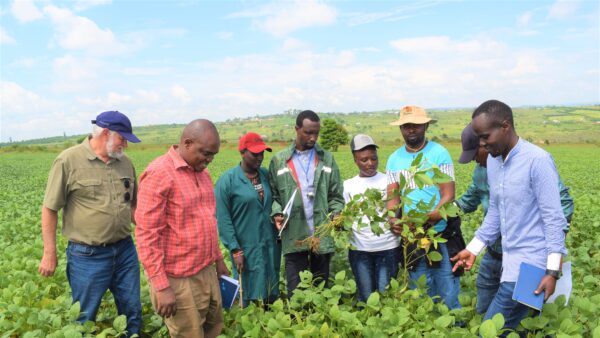In the face of the ongoing mergers and acquisitions, that is. I have to ask this question as the seed industry cites the need for consolidation is to improve synergies. Businesses at all levels seek to improve synergies, but this doesn’t necessarily mean they spend billions of dollars doing it. So what’s the real impetus?
Is it shareholders? Is it the down ag economy? Is it the market maturing? Is it the regulatory environment? It’s likely a combination of these factors all converging at once, but I can’t help but think our current regulatory environment plays a bigger role than what’s been discussed or covered in media.
Now I recognize I’m young in this industry compared to many of the industry’s experts but during the past 20 years, history shows us that government, regardless of which party has been in office, has done nothing but get bigger.
The cost of discovery, development and authorization of a new plant biotechnology trait introduced between 2008 and 2012 is $136 million, according to CropLife International. The time from the initiation of a discovery project to commercial launch is 13.1 years on average. But the number that catches my eye is the length of time associated with registration and regulatory approval. In 2002, the time associated with registration and regulatory affairs was a mean of 3.7 years. In 2011, the time frame increased to an estimated 5.5 years. CropLife reports that regulatory science, registration and regulatory affairs account for the longest phase in product development, estimated at 36.7 percent of total time involved. That’s more than one-third of the total process, just for registration and regulatory approval.
And we haven’t even touched on other regulations that impact business owners and agriculture. Policymakers, while trying to protect the environment and curtail climate change, place undue burden on farmers and agribusinesses. One of the most ludicrous regulations put forth was to regulate farm dust. You can’t even drive down a rural Missouri road without stirring up a little dust, let alone plant or harvest a field.
Then there’s the controversial “Waters of the United States” rule, more commonly known as WOTUS. This regulation, issued by the Environmental Protection Agency and the Army Corps of Engineers, seeks to clarify and expand the agencies’ regulatory jurisdiction under the Clean Water Act. The rule vastly expands the agencies’ jurisdiction and attempts to regulate all land issues. As a result 13 states (Alaska, Arizona, Arkansas, Colorado, Idaho, Missouri, Montana, Nevada, New Mexico, North Dakota, South Dakota and Wyoming filed suit, claiming that the WOTUS rule is a threat to state sovereignty because it asserts federal jurisdiction over wetlands and waters, and even some relatively dry land that should be subject to state government control. According to the Supreme Court, the WOTUS rule “allows EPA regulation of waters that do not bear any effect on the ‘chemical physical, and biological integrity’ of any navigable-in-fact water,” and therefore exceeds the limits on federal regulatory authority.
So not only were they going to tell businesses and landowners what they could and couldn’t do with their land, but they are going to dictate employee pay for overtime. In 2014, President Obama directed the Secretary of Labor to update the overtime regulations to reflect the original intent of the Fair Labor Standards Act, and to simplify and modernize the rules so they’re easier for workers and businesses to understand and apply.
The final rule raises the salary threshold indicating eligibility from $455 per week to $913 per week, or $47,476 per year. The rule goes into effect Dec. 1, 2016. In response to the rule, employers can pay time-and-a-half for overtime work, raise workers’ salaries above the new threshold, limit workers’ hours to 40 hours per week (which is not feasible with the cyclical demands of agriculture) or some combination of the above.
Back in 2011, the Department of Labor proposed a rule that would have banned kids under the age of 16 from working with animals and handling pesticides. The way it the rule was written, kids wouldn’t have been able to use a battery-powered flashlight or climb a ladder above 3 feet. This would have meant kids couldn’t participate in some 4-H projects or on the school farm.
Now don’t get me wrong, I’m all for safety and taking proper precautions but there needs to be some commonsense associated with the rules and regulations put forth today. We haven’t even touched upon EPA’s emissions standards, the GMO labeling debacle that went down over the past few years, or healthcare and its impact on agricultural businesses.
Syngenta has had negative net income growth in each of the past three years — two of them in double digits. DuPont has had negative net income growth in two of the past four years. Dow’s income growth looks like that of an EKG heart attack patient, the numbers are up and down. Monsanto is in a similar situation. Bayer is the only one with a positive story to tell.
This is a volatile market — there’s no doubt. At the root of this is the need to create synergies and get more done, capitalizing on the strengths of a partner. If you don’t innovate, you’re not going to make it. Our regulations and tax policies make it very difficult to maintain steady net income growth. We don’t need more regulators removed from politics, maybe just the opposite. We need more regulators accountable to politicians who represent farmers and people in the industry who are being unduly regulated. What if we took one-third of the dollars companies spent to deal with regulations and put it toward research and development. Companies would have more resources to innovate, upping competition and delivering farmers more products. And maybe instead of consolidation, we’d see expansion.













